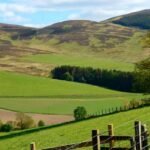Archaeologists in Guardbridge, Scotland, have unearthed evidence of human activity spanning 10,000 years during digs ahead of a new housing project. The finds in Fife reveal everything from ancient tools to medieval kilns, offering a rare glimpse into the region’s past.
Discovery Shakes Up Views on Early Scottish Life
Experts from GUARD Archaeology led the excavation in a single field near the River Eden. They started work before builders moved in to construct homes. What they found surprised everyone involved.
The site shows signs of Scotland’s first people from the Upper Paleolithic period. These early hunters made flint tools there around 10,000 years ago. As time passed, Neolithic farmers settled in, leaving behind pits filled with burnt grains and pottery.
Later periods brought more complex structures. A late Bronze Age fort stood nearby, with roundhouses dotting the landscape. Iron Age residents wove cloth and crafted jewelry, hinting at a bustling community.
The area fell quiet at the end of the Iron Age but saw a comeback between 900 and 1300 AD. People built corn-drying kilns then, pointing to farming revival.
Maureen Kilpatrick, who directed the team, called it unexpected. She noted how one spot held the whole prehistory of Fife.
This ties into broader trends in Scottish archaeology. Recent digs across the country uncover similar multi-era sites, showing how people adapted over millennia.

Key Finds Paint a Vivid Picture of Daily Life
Diggers pulled out artifacts that tell stories of everyday existence. Flint tools from the Paleolithic era suggest temporary camps for hunting and gathering.
Neolithic items include saddle querns for grinding grain. These show early farming techniques that changed how people lived.
Bronze and Iron Age remnants stand out most. Roundhouses, some reconstructed in drawings, had hearths and storage areas. Spindle whorls and loom weights prove textile work happened on site.
Shale bracelet fragments indicate personal adornment. Not just warriors lived here; families did too.
Medieval kilns for drying corn highlight later agricultural focus. These structures helped preserve food in a changing climate.
All these pieces fit together like a puzzle. They show Guardbridge as a prime spot due to its river access and fertile land.
Experts say the site’s location near St. Andrews added to its appeal over time. Pilgrims crossed the nearby bridge in the 1500s, but roots go much deeper.
How This Fits into Scotland’s Bigger Archaeological Story
Scotland boasts many ancient sites that draw global interest. This Guardbridge find joins ranks with places like Skara Brae in Orkney, preserved for thousands of years.
Skara Brae, uncovered by a storm in 1850, shows Neolithic village life. It became a World Heritage Site in 1999.
Other recent discoveries include a possible Neolithic hall in 2023 and prehistoric carvings in 2021. These highlight ongoing efforts to rewrite history.
In 2025, campaigns like Scotland Digs invite public involvement. People can join excavations or learn about finds.
This Guardbridge project came from required checks before development. Laws ensure history gets preserved amid modern growth.
Archaeologists analyzed the site with modern tools like carbon dating. Results confirm the 10,000-year timeline.
The team published a free report online. It details every layer and artifact for anyone to study.
Timeline of Guardbridge Discoveries
Here’s a quick look at the periods uncovered:
| Period | Approximate Dates | Key Finds |
|---|---|---|
| Upper Paleolithic | 10,000 years ago | Flint tools, signs of hunter-gatherers |
| Neolithic | 6,000-4,000 years ago | Pits with grains, pottery, querns |
| Late Bronze Age | 3,000-2,500 years ago | Fort structures, early roundhouses |
| Iron Age | 2,500-2,000 years ago | Spindle whorls, loom weights, bracelets |
| Medieval | 900-1300 AD | Corn-drying kilns, farming evidence |
This table shows how activity evolved over time.
Why This Matters for Modern Scotland
Findings like these boost local pride and tourism. Guardbridge, once known for its historic bridge, now claims deeper roots.
They also inform future builds. Developers must consider heritage, balancing progress with preservation.
On a wider scale, such digs combat climate threats to sites. Rising seas and storms endanger coastal history, as seen in Orkney.
Experts predict more discoveries as technology improves. Drones and AI help spot hidden features faster.
This story reminds us how the past shapes today. It connects current Scots to ancestors who thrived in the same spots.
Challenges and Future Plans for the Site
Excavations wrapped up, but analysis continues. Artifacts head to labs for deeper study.
One challenge was the site’s scale. Covering 10,000 years in one field meant careful layering work.
Weather played a role too. Rainy Scottish days slowed progress, but the team pushed through.
Looking ahead, some finds might go on display. Museums in Fife could showcase them.
Public talks and online resources will share the story. This keeps history alive for all.
Similar projects pop up elsewhere. A 2025 dig in the islands uncovered ancient tools, echoing Guardbridge.
These efforts build a fuller picture of Scotland’s story.
Lessons from Guardbridge for Global Archaeology
This dig shows how one place can hold vast history. It inspires searches worldwide for overlooked spots.
In places like the Americas or Asia, similar multi-era sites emerge. They reveal human resilience across eras.
For Scotland, it underscores the need for funding. Government and private support keep digs going.
Experts urge more youth involvement. Programs teach skills and spark interest in the field.
Guardbridge proves archaeology still surprises. What lies beneath our feet can change how we see the world.
Share your thoughts on this amazing find. Have you visited similar sites? Comment below and spread the word to friends who love history.


















